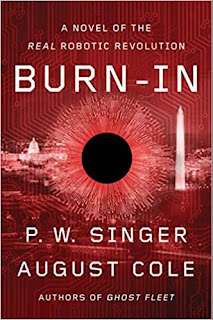Modern Monday - Burn In: A Review
Robot stories are not new, nor is a robot working with a police officer a new trope. Yet Burn In, by P.W. Singer and August Cole, dares to tell such a tale in the near future. The setting is Washington, D.C., roughly 20 years from now.
Special Agent Lara Keegan is introduced to us on the hunt. She successfully takes down a terrorist agent despite being told repeatedly that the individual was not flagged by surveillance algorithms, and is even outright ordered to wave off. After the suspect is taken down, a case filled with explosives is discovered on his person, and Keegan is established as the sort of agent whose instincts rise above algorithms, and who can defy orders when she is certain that she is right.
Despite this, or perhaps because of this, she is tapped to be partnered with a new, robotic "partner" named TAMS (Tactical Autonomous Mobility System). Keegan regards this newly assigned partner with disdain, as it is her instincts, and their ability to see beyond mere algorithms, which is her primary strength. She calls this new assignment a "burn in," because the technology is being given a test run before final approval.
Keegan eventually learns to cope with her new robot, and even to like it on some fundamental level. After repeatedly re-defining the robot's parameters (telling it to not go off on tangents, list things ad infinitum, only say "okay" instead of some lengthy acknowledgement, etc.), she comes to tolerate working with it. Then, while chasing down a suspect, TAMS surprises her by anticipating where the suspect will go, and heading him off at precisely the correct location, despite previous orders telling it to remain where it was. The robot's ability to see beyond orders causes Keegan to wonder, and to suspect that maybe having TAMS around might not be such a bad idea after all. Adding to the drama of the situation, her daughter forms a loving attachment to TAMS. Her estranged husband, by contrast, loathes the robot, and won't tolerate it in their home.
Meanwhile, a terrorist is plotting to expose what he believes are the evils of technology, Ted Kaczynski style. He plants a small bug in the code of the city's water regulation system which cascades and leads to a sudden flood. This is but the first of many steps he takes to persuade humanity to throw down its tech and return to the earth.
The story is somewhat similar to the brief television show, Almost Human (2014), in which a cop named Kennex (Karl Urban) is partnered with an android named "Dorian," DRN-0167 (Michael Ealy). Indeed, Almost Human and Burn In even take place in roughly the same near-future setting. Yet while "Dorian" suffers from psychosis caused by too much complexity, TAMS struggles with adding the complexities needed to be an effective field agent. It lacks "instincts," and Keegan tries to teach it that, in so far as an android can be taught such things.
Burn In is also reminiscent of the robot stories of Isaac Asimov, without Asimov's talent for clarity. There are times the story's descriptions go off into brief tangents which do not add much, and which can easily throw a reader's train of thought. The underlying idea of the story plot is neither unique nor profound, and the characters are derivative, not original. Yet the story does offer a fresh perspective on how emergent non-biological intelligence (I prefer N.B.I. to the inaccurate term, "A.I.") might come about. The lack of originality regarding the characters and ideas is more than compensated for by this fresh perspective, and by a graphic depiction of what the world might really be like in 20 years - a bold move for any author! That alone makes the book well worth anyone's time.
I give Burn In 4 out of 5 stars. An interesting read for these interesting times!
Eric
*




Comments
Post a Comment